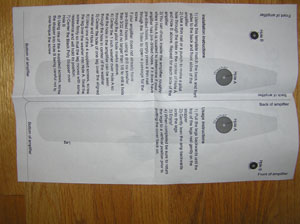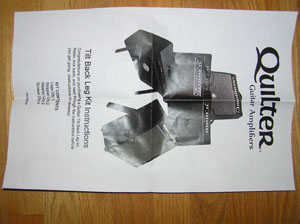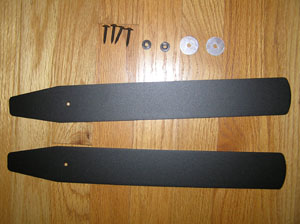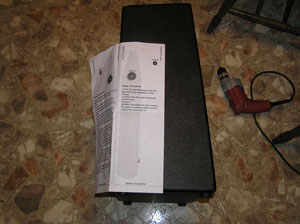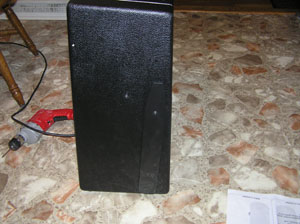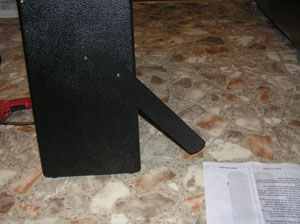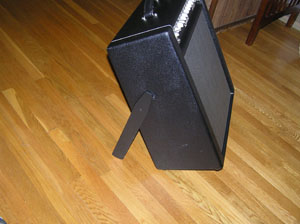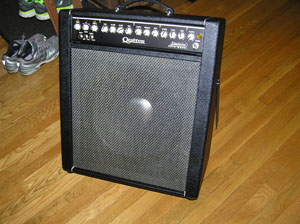Quilter Steelaire Pro Amplifier Review
|
I bought this Quilter Steelaire Pro amp in late October of 2014 from AMS (American Musical Supply). CLICK HERE!
to see the amp as listed on the AMS web site. I contacted AMS and was able to work out a deal. AMS includes a free 12 month extended warranty.
Quilter offes a "Steelaire Legmout Controller" CLICK HERE! for a list price of $149 but I passed on that. You can wire up your own foot switch with just the buttons and style of box you like using the instructions posted by Quilter CLICK HERE! or you can reference the wiring diagram I made. CLICK HERE to see my wiring diagram!. Like most people I agonized greatly over this decision. Should I buy the Steelaire Pro or Combo or perhaps the Walker Stereo Steel (2 speakers yippee!) or just stay with my Fender Steel King? I have had good luck in the past with the Steel King, a Webb 6-14-E, twin Peavey Nashville 400's (factory modded) and a bit less success with the Peavet Nashville 112 and Fender Twin Reverb amps. At many of the steel guitar shows I've been at, the Walker Stereo Steel amp always stood out as having excellent power, projection, tone and coverage. I've tried a bunch of tube preamps to try to "warm up" the sound but it seems that almost all of the tube sound I've come to love for harmonics and compression comes from the tube power section including the tube rectifier sag and high power tubes reacting with the speaker (and not from the tube preamp). This time however I was opting for a lighter more compact setup. You can see links below for my review of other amps with pedal steel and this one, like those, are really just at home, in my basement or studio kinds of reviews. You really need to try these amps out for yourself to decide if they work for your style of music and setup and on a real stage setting. Your selection and preference of guitar, pickups, cords, effects, amp placement, foot volume type, playing style, weight and price preferences, whether you mic the amp and a lot more factors are involved in how your sound comes out.
Click here to view the Quilter Steelaire Owner's manual.
|

|
|
In case your're interested, here's some links to other reviews and amp sound samples I've produced:
- Fender Steel King, Hot Rod Deluxe, Revelation Rack System
- Gibson BR-9
- Fender Princeton Reverb Re-Issue
- Fender Deluxe reverb
- Fender Blues Junior Tweed
- Fender Super Champ XD
- Fender Vibro Champ
- 1974 Fender Princeton Reverb
- Fender Dual Showman
- Rack System - Revelation Preamp, Stewart Woorld Power Amp, Lexicon MPX1, Kappalite PSeaker cabs
- Peavey Black Widow Speaker In A Fender Steel King
- I included pics of my existing Fender Steel King setup for later comparision to the Quilter in the same setting
- The sound sample recordings were made with the mic as pictured
- A 9 VDC power cord is included!
- The carrying handle is heavy duty, has a comfortable grip and can be pressed downward to lay flat against the top of the amp
- Workmanship as far as I can see is flawless
- There are two slots in the top of the speaker cab for wires to feed through. Simple but a nice touch!
- A single simple red thumb screw secures the rack amp to the speaker cabinet. The thumb screw is not retained so it'd be easy to misplace!
- The power cord locks in place at the amp receptacle!
- The power amp rack comes with 4 rubber feet so it can be safely placed on any surface without marring it
- The speaker cabinet makes a nice extension cabinet as removing the power amp does not uncover any cabinet holes
- The speaker cab has 4 rubber feet, and no casters. Casters are probably not needed due to the light weight and in fact would add weight if they were there!
- The cover is attractive, super heavy duty, plush AND has a velcro flap covered pocket on the back!
- I pictured the amp next to a Fender Steel King and a Princeton Reverb from all angles for a size reference that msot people can relate to. These amps are shown from all angles and the Steel King is shown with and without casters
- With my amp stand the amp support brackets do not rest against the amp cabinet. I added a brace as shown in the pictures to stop the amp from tipping backwards. It would be nice if the back amp cross piece was lower or if another backpiece was added to make it compatible with common amp stands. I didn't try the amp on a chair to see if this was a concern there.
There are quite a few pictures below. Click on them to see them full size or at least sized to a browser window. Click on the picture again if needed to zoom in even more! After taking and reviewing these pictures a few interesting design details became apparent.
|
|
All sound samples used a Shure SM-57 placed 2" from the grill cloth and pointed straight at the edge of the speaker cone. The mic was fed to a Studio Projects pre-amp with the tube gain set on zero then to a Zoom R24. The R24 .wav file samples were ported into Reaper where they were edited into sound bytes with no compression or effects added. They were then converted to .mp3 files at a fixed 320 kbps rate to be posted here. On a few of the sound samples you will hear a short quirk in the beginning. This is not in the original wav files and was produced by the Lame (brand name) MP3 generator provided with Reaper. It was the only MP3 converter I had handy as the license on other file converter expired.
E9th Pedal Steel Samples
- MSA Legend 18K ohm Truetone pickups, George L'S cords, Goodrich volume pedal with Dunlop HotPotz, no effects pedals just direct to amp
Amp settings: Bass 8, Low Mid 4, Hi-Mid 6.5, Treble 5, Limiter 5, Master 5, Gain 1 4, gain 2 4, Rev Level 5, Dwell 6, Tone 6, CH1 IN, Mode: CH 1+2
| Sound Sample 1 | Sound Sample 2 | Sound Sample 3 | Sound Sample 4 |
| Sound Sample 5 | Sound Sample 6 | Sound Sample 7 | Sound Sample 8 |
| Sound Sample 9 | Sound Sample 10 | Sound Sample 11 | Sound Sample 12 |
C6th Pedal Steel Samples
- MSA Legend 18K ohm Truetone pickups, George L'S cords, Goodrich volume pedal with Dunlop HotPotz, no effects pedals just direct to amp
Amp settings: Bass 8, Low Mid 4, Hi-Mid 6.5, Treble 5, Limiter 5, Master 5, Gain 1 4, gain 2 4, Rev Level 5, Dwell 6, Tone 6, CH1 IN, Mode: CH 1+2
| Sound Sample 1 | Sound Sample 2 | Sound Sample 3 | Sound Sample 4 |
| Sound Sample 5 | Sound Sample 6 | Sound Sample 7 | Sound Sample 8 |
Reverb Samples
Reverb with Intensity variations followed by Dwell variatiions followed by Tone variations
Reverb Sample 1
Overdrive/Distortion Samples with steel guitar
Pedal Steel E9th distortion - CH1 Gain 10, Ch2 Gain 10, Limiter 0, Reverb 2.5, Master 1, Ch1 IN, Mode Ch 1+2 (all other settings as above)
Steel Guitar Overdrive Sample 1
Archtop Electric Sound Samples
-
Amp settings: Bass 5.5, Low Mid 4, Hi-Mid 7, Treble 7, Limiter 5, Master 2, Gain 1 4, Rev Level 4.5, Dwell 5, Tone 5, CH1 IN, Mode: CH1
| Sound Sample 1 | Sound Sample 2 | Sound Sample 3 | Sound Sample 4 |
| Sound Sample 5 | Sound Sample 6 | Sound Sample 7 | Sound Sample 8 |
| Sound Sample 9 | Sound Sample 10 |
Ovation Guitar Sound Samples
-
Amp settings: Bass 5.5, Low Mid 4, Hi-Mid 7, Treble 7, Limiter 5, Master 2, Gain 1 4, Rev Level 4.5, Dwell 5, Tone 5, CH1 IN, Mode: CH1
| Sound Sample 1 | Sound Sample 2 |
Electric Fiddle Sound Samples
-
Amp settings: Bass 5.5, Low Mid 4, Hi-Mid 7, Treble 5, Limiter 5, Master 2, Gain 1 4, Rev Level 4.5, Dwell 5, Tone 5, CH1 IN, Mode: CH1
| Sound Sample 1 | Sound Sample 2 | Sound Sample 3 | Sound Sample 4 |
| Sound Sample 5 |
Telecaster Sound Samples
-
Amp settings: Bass 5.5, Low Mid 4, Hi-Mid 7, Treble 6, Limiter 5, Master 2, Gain 1 4, Rev Level 4.5, Dwell 5, Tone 5, CH1 IN, Mode: CH1
| Sound Sample 1 | Sound Sample 2 | Sound Sample 3 | Sound Sample 4 |
| Sound Sample 5 |
Vibrato Sound Samples
-
Amp settings: Bass 5.5, Low Mid 4, Hi-Mid 7, Treble 6, Limiter 5, Master 2, Gain 1 4, Rev Level 4.5, Dwell 5, Tone 5, CH1 IN, Mode: CH1
| Sound Sample 1 |
Tele With Distortion Sound Samples
-
Amp settings: Bass 5.5, Low Mid 4, Hi-Mid 7, Treble 6, Limiter 5, Master 2, Gain 1 4, Rev Level 4.5, Dwell 5, Tone 5, CH1 IN, Mode: CH1
| Sound Sample 1 |
Pictures! Click on them to see full sized pics.
 |
 |
 |
 |
 |
 |
 |
 |
 |
 |
 |
 |
 |
 |
 |
 |
 |
 |
 |
 |
 |
 |
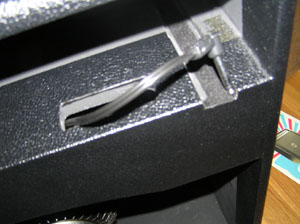 |
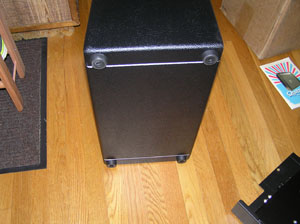 |
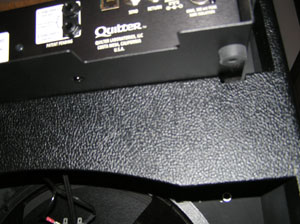 |
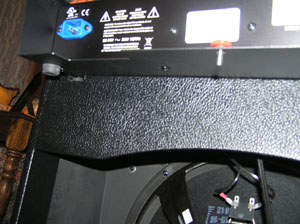 |
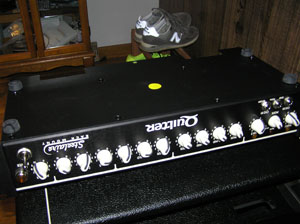 |
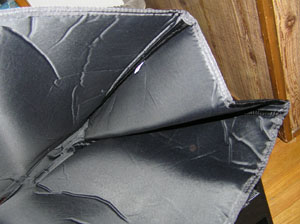 |
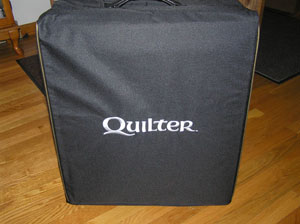 |
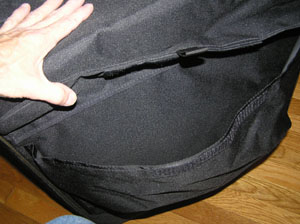 |
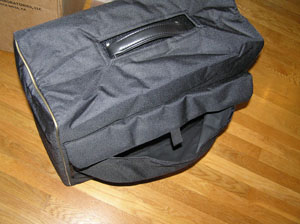 |
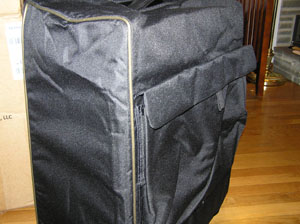 |
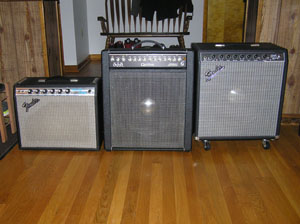 |
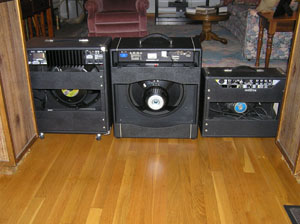 |
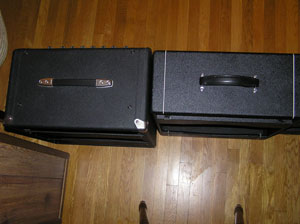 |
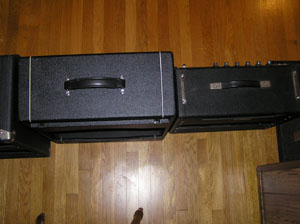 |
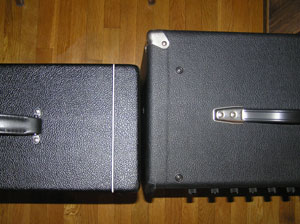 |
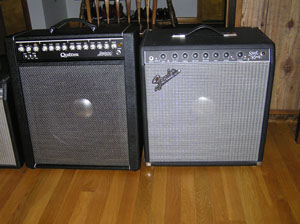 |
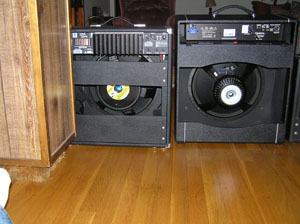 |
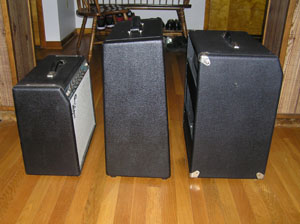 |
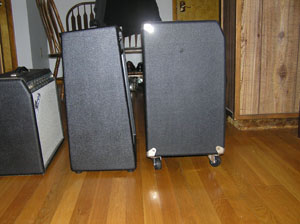 |
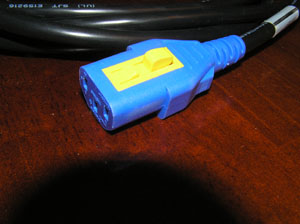 |
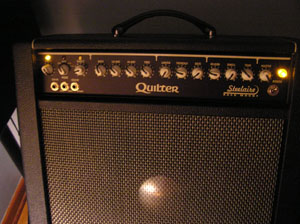 |
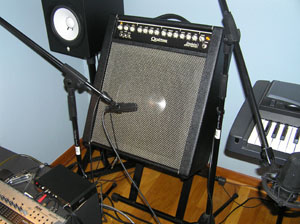 |
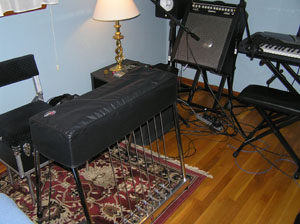 |
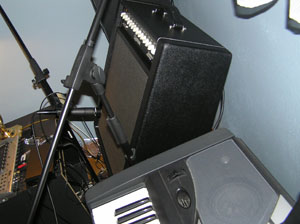 |
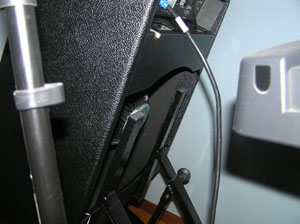 |
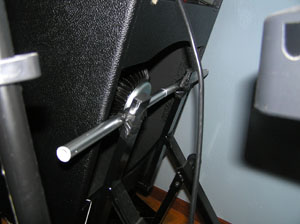 |
Addendum for tilt back legs.
I decided to try out the tilt-back legs that Quilter offers for this amp and the Steelaire Combo. The legs are made of aluminum and they are super light! I located the pre-drilled pilot holes for the leg stops and used those as a locator for the provided template and to locate the leg mount holes. I didn't try to find the leg mount pilot holes under the tolex! The recommended drill is 3/32" to 1/8" so I used a 0.105" drill I had laying around. Installation took about an hour. I did have to hacksaw off just the very tips of all 4 mounting screws as they do project slightly through the cabinet leaving exposed sharp edges inside. The legs once installed stay in place nicely when not in use and leave the amp in a stable tilt-back position when in use. See detailed pictures below.
I just noticed that the controls knobs are not exposed and do not extend beyond the plane of the amp front edges. So there's no need for a knob guard or any worry about bumping the amp knobs while moving it.
I made some audio recordings with the amp in the tilt back position. Surprisingly I couldn't hear any more bass as compared to having it on the amp stand and I didn't care for the mid range tone nearly as much. Bass was still clean though. The amp looks cool
positioned that way! One other variable is that the amp was positioned in the middle of the room and not near a wall. No doubt tilting it back and placing it near a back wall would change the sound as well.
Tilt Back Sound Samples
-
Amp settings: Bass 7, Low Mid 4, Hi-Mid 7, Treble 6, Limiter 5, Master 2, Gain 1 4, Gain 2 4, Rev Level 4.5, Dwell 5, Tone 5, CH1 IN, Mode: CH1+2
| Tilt Back Sound Sample 1 | Tilt Back Sound Sample 2 | Tilt Back Sound Sample 3 | Tilt Back Sound Sample 4 |
